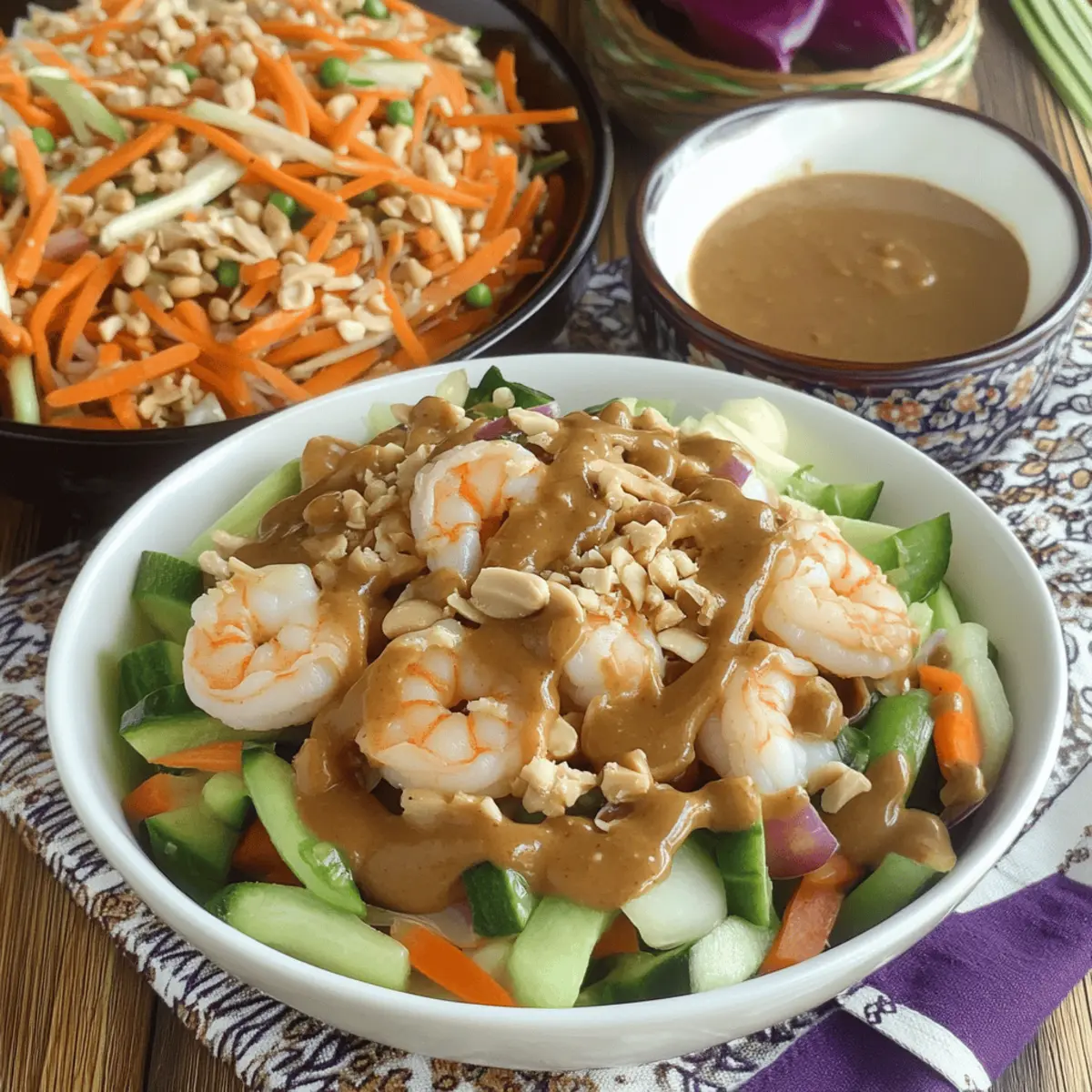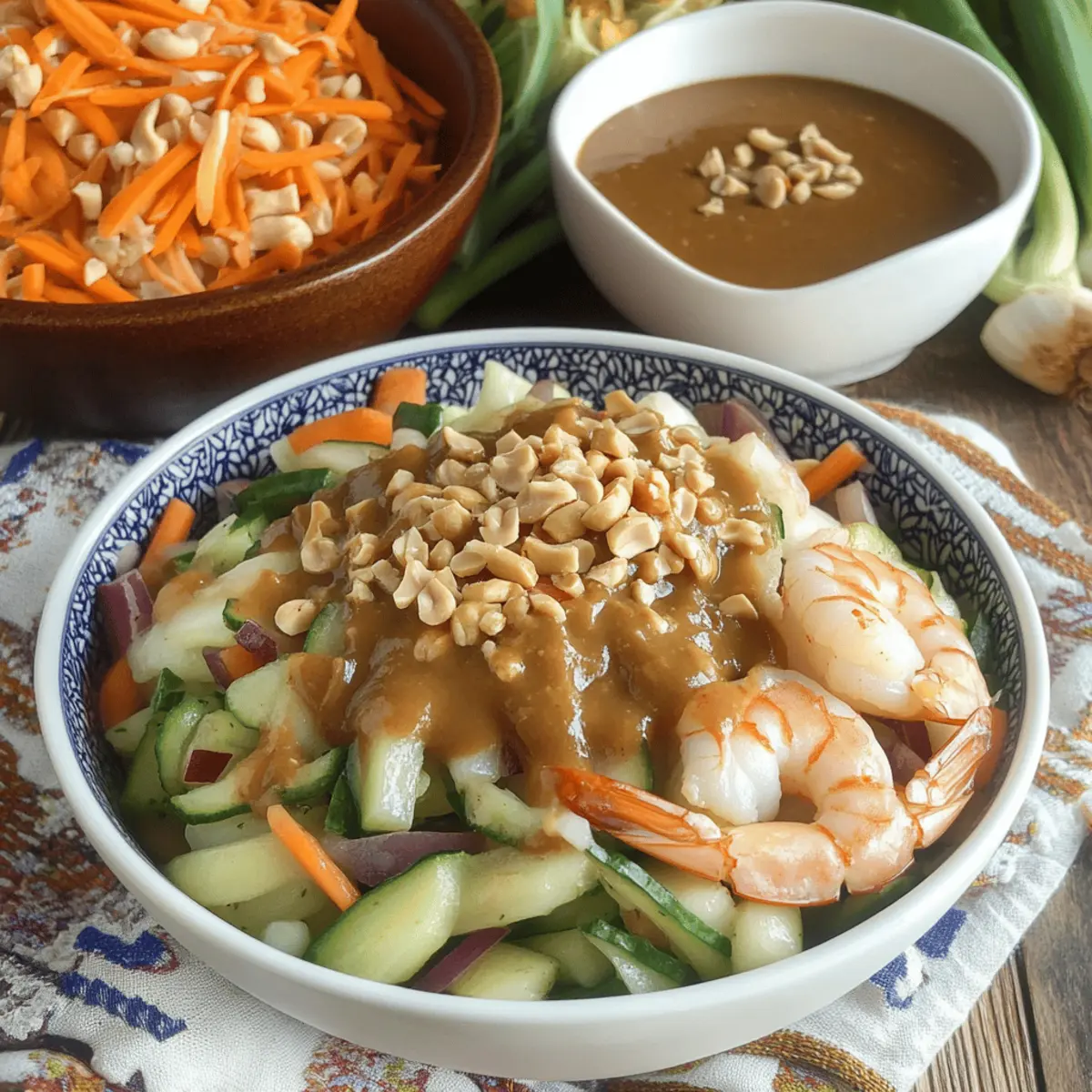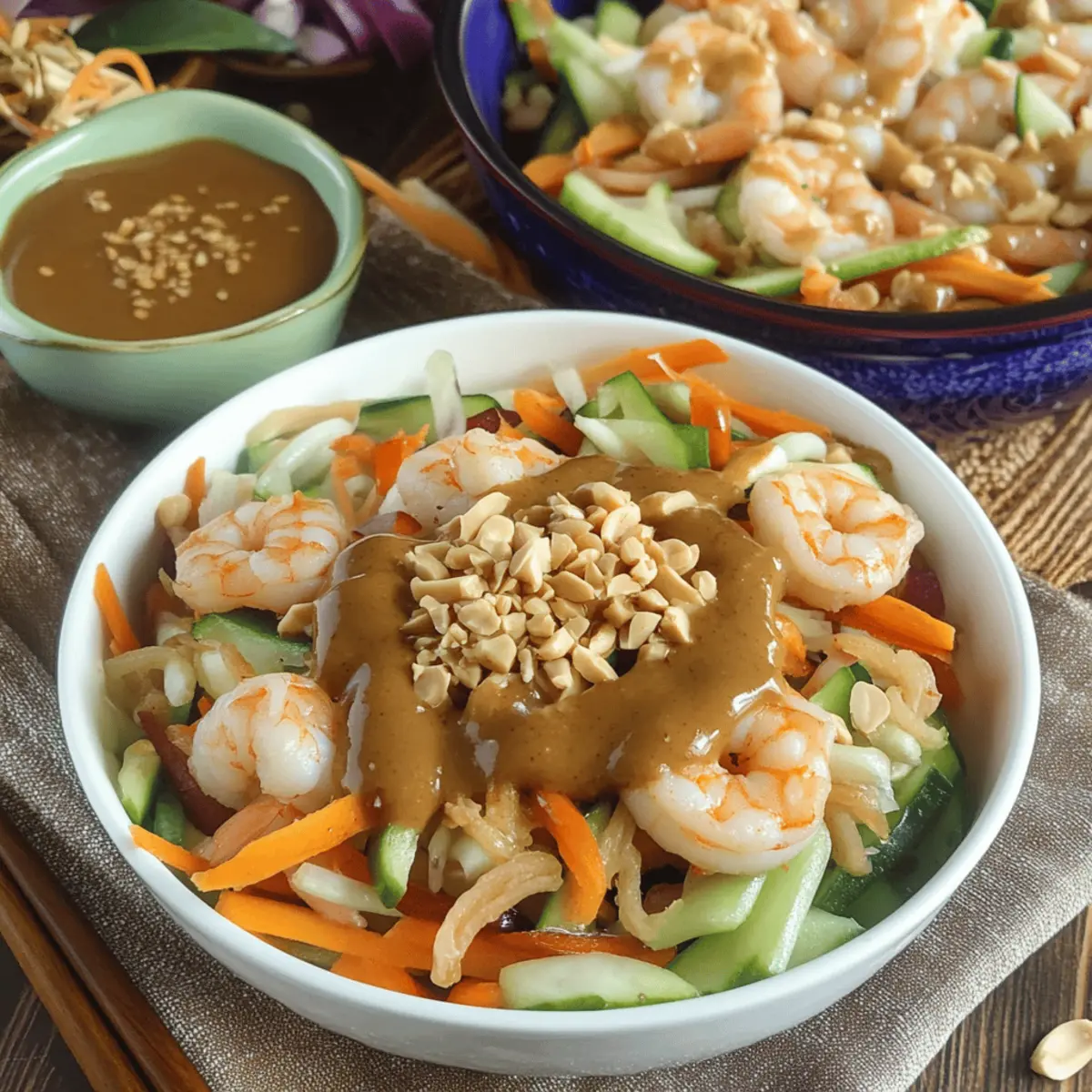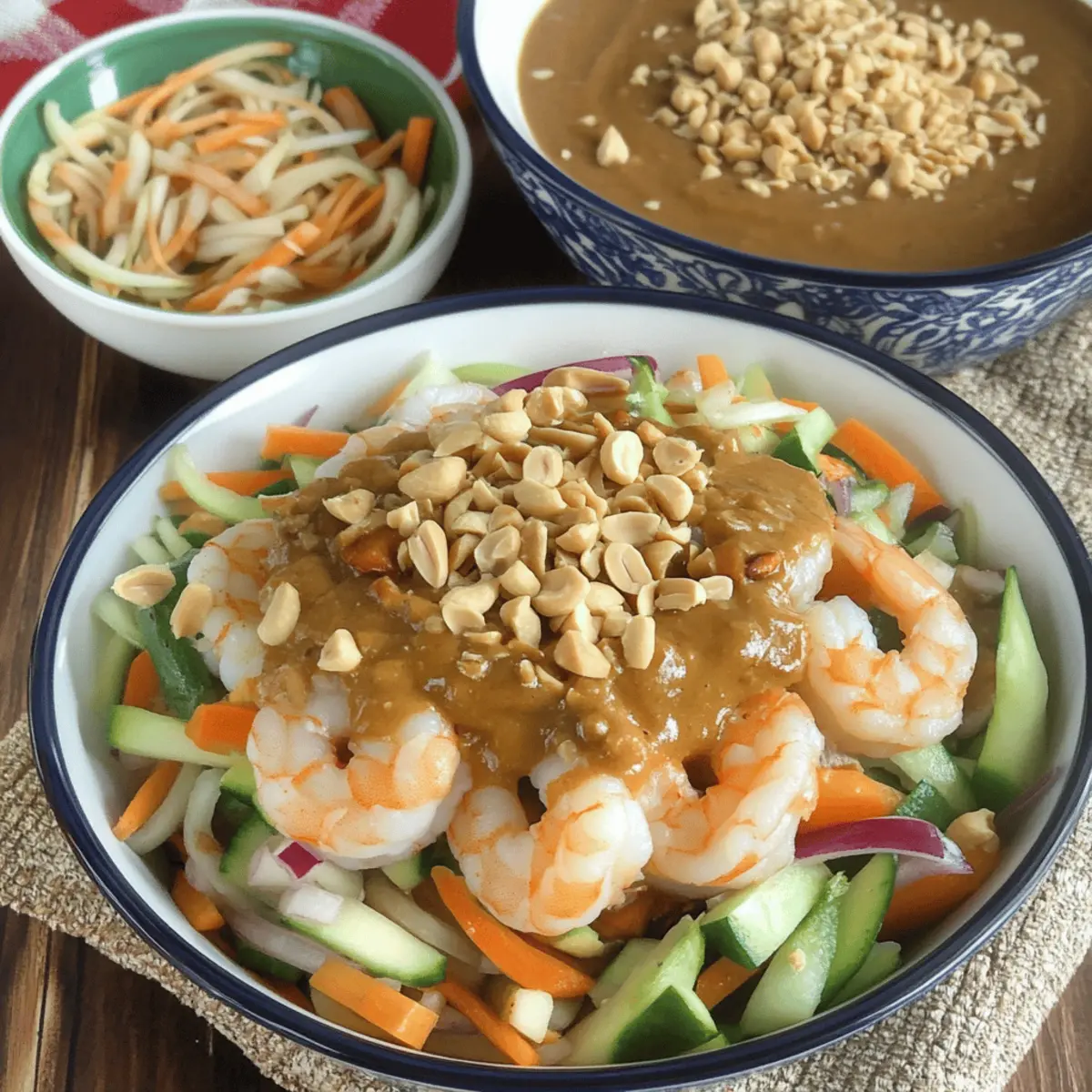Stepping into the vibrant world of Filipino cuisine is like unwrapping a beautifully colored gift—the excitement and anticipation of something delightful await. Today, I’m thrilled to share my take on Lumpiang Hubad, a healthy Filipino spring roll salad that brilliantly showcases fresh ingredients and flavors that brighten your plate. This dish is not only easy to prepare but also a fantastic vegetarian option, perfect for those seeking a light yet satisfying meal. Whip it up for a casual family dinner or impress guests at your next gathering with this colorful medley of sautéed vegetables and proteins. Are you ready to explore the delicious layers of flavors and textures that make Lumpiang Hubad a true culinary gem? Let’s dive in!

Why Is Lumpiang Hubad So Popular?
Vibrant, Nutrient-Packed: Bursting with colorful vegetables, Lumpiang Hubad is a feast for the eyes and a boost for your health. Easy Preparation: This dish doesn’t require advanced cooking skills; you’ll have a meal ready in no time! Versatile Ingredients: Adjust proteins and veggies based on what you have on hand; it’s perfect for sneakily using up leftovers. Delicious Sauce: The creamy peanut sauce adds a rich layer of flavor that will leave everyone wanting more. Crowd-Pleasing: Great for both family dinners and gatherings, this dish shines as a lighter alternative to greasy takeout while staying true to Filipino culture. Enjoy it as a standalone meal or with steamed rice for an added touch!
Lumpiang Hubad Ingredients
For the Sautéed Base
• Oil – Use vegetable or canola oil for a neutral flavor, perfect for sautéing.
• Onion – Adds depth and aroma; shallots can substitute for a milder taste.
• Garlic – Freshly minced garlic enhances flavor; it’s a key ingredient for aroma.
• Ground Pork – Provides richness; replace with ground turkey or omit for a vegetarian option.
• Fish Sauce – Imparts umami; use soy sauce or miso as a vegetarian substitute.
• White Ground Pepper – Adds mild heat; black pepper can be used for extra kick.
• Shrimp – Adds sweetness and a seafood element; omit or replace with tofu for vegetarian.
• Sweet Potato – Provides natural sweetness and texture; butternut squash works well as an alternative.
• Carrot – Offers crunch and sweetness; any root vegetable can be used instead.
• Cabbage – Adds bulk and freshness; savoy or napa cabbage are great substitutes.
• Green Beans – Adds crisp texture; snap peas can be an alternative.
• Salt – Enhances flavors; adjust according to taste preferences.
For the Sauce
• Cornstarch – Thickens the sauce; arrowroot powder can be used as a substitute.
• Soy Sauce – Adds saltiness and umami; try Tamari for a gluten-free option.
• Crushed Peanuts – Provide texture and flavor; sunflower seeds are perfect for nut-free alternatives.
• Water – Helps achieve desired sauce consistency.
• Brown Sugar – Balances flavors with a touch of sweetness; coconut sugar works as an alternative.
Explore the delightful layers of flavors and textures in Lumpiang Hubad with these fresh ingredients!
Step‑by‑Step Instructions for Lumpiang Hubad
Step 1: Prepare the Sauce
In a medium bowl, combine 2 tablespoons of cornstarch with 1 cup of water and 4 tablespoons of soy sauce; set aside. In a heated pan over medium heat, toast ½ cup of crushed peanuts until they turn light brown and fragrant. Reserve half for garnish, then add the remaining peanuts to the pan along with 2 tablespoons of brown sugar and 2 minced garlic cloves. Stir until the sugar dissolves.
Step 2: Sauté Vegetables
Heat 2 tablespoons of oil in a large wok or skillet over medium-high heat. Add 1 diced onion and 3 minced garlic cloves, sautéing until fragrant, about 2-3 minutes. Toss in ½ pound of ground pork and 2 tablespoons of fish sauce, breaking the meat into smaller pieces. Cook for 3 minutes until the pork is no longer pink. Then, add ½ pound of shrimp, cooking until they turn pink and opaque, about 2-3 minutes more.
Step 3: Add Main Vegetables
Stir in 1 large sweet potato (diced) and 2 medium carrots (julienned), adding a splash of water to help them steam. Cover the pan and cook for 3-5 minutes until the sweet potatoes are just tender but still firm. This enables the vibrant flavors to meld while keeping the vegetables wholesome. The mixture should remain slightly crunchy for the ideal texture in your Lumpiang Hubad.
Step 4: Finish with Greens
Add 2 cups of chopped cabbage and 1 cup of trimmed green beans to the pan. Season with salt to taste, and toss everything together, cooking for an additional 2-3 minutes. Stir continuously until the greens are tender yet still crisp, allowing them to maintain their bright color and vibrant nutrients in this healthy Lumpiang Hubad dish.
Step 5: Serve
Once prepared, plate the sautéed mixture in a vibrant serving bowl. Generously drizzle your homemade sauce over the top, allowing it to enrich the flavors. Finish with a sprinkle of the reserved crushed peanuts for added texture and a delightful crunch. Serve your Lumpiang Hubad warm, whether on its own or with a side of steamed rice for an enjoyable meal.

What to Serve with Lumpiang Hubad
Elevate your meal with delightful complements that enhance the fresh flavors of this vibrant spring roll salad.
- Jasmine Rice: The subtly fragrant rice adds a perfect balance to the savory lumpiang hubad, soaking up the delicious sauce with each bite.
- Fresh Green Salad: A crisp cucumber and tomato salad provides a refreshing crunch that contrasts beautifully with the warm sautéed vegetables.
- Sweet Mango Slices: Juicy slices of ripe mango add a delightful sweetness, making an excellent contrast to the savory and umami flavors of the dish.
- Grilled Chicken Skewers: Tender grilled chicken seasoned with garlic and herbs adds an extra protein option, perfect for those who prefer a heartier meal.
- Coconut Iced Tea: A lightly sweetened iced tea infused with coconut makes a cooling beverage that harmonizes well with the lively flavors of lumpiang hubad.
- Chili Garlic Sauce: For a spicy twist, drizzle on some chili garlic sauce to heat things up—a little goes a long way in boosting the flavor profile!
- Peanut Sauce Dip: Serve alongside a creamy peanut sauce for an extra indulgent touch; it further complements the dish’s flavor while adding richness.
- Fruit Sorbet: A light mango or coconut sorbet provides a frosty dessert option that cleanses the palate and wraps up your meal with a refreshing finish.
Lumpiang Hubad Variations & Substitutions
Feel free to mix and match ingredients to make this delightful dish your own and savor every bite!
- Vegetarian Option: Replace ground pork and shrimp with tofu or seitan, providing a hearty, protein-packed alternative for plant-based eaters.
- Seasonal Veggies: Use seasonal vegetables like bell peppers or bok choy to add freshness and variety to your dish, enhancing flavor and nutrition.
- Crunchy Wrap: Serve your Lumpiang Hubad wrapped in crisp lettuce leaves or rice paper for a fun twist, making it interactive and playful for gatherings.
- Flavor Boost: Add a splash of lime juice or rice vinegar to the sauce for a zesty kick, which brightens up the flavors even further.
- Nut-Free Alternative: Substitute crushed peanuts with sunflower seeds for those with nut allergies, maintaining that delightful crunch while keeping it safe for everyone.
- Heat Level: Spice things up by adding chili flakes or fresh chili slices to the sautéed mix for a warm, delightful kick that enhances the overall experience.
- Rice Alternative: Instead of using traditional rice, try cauliflower rice for a low-carb twist that complements the colorful veggies beautifully.
- Herb Infusion: Incorporate fresh herbs like cilantro or basil into your sautéed vegetables for an aromatic twist that adds another level of flavor depth.
As you let your creativity flow, consider trying out some of these variations. Explore different flavor profiles and have fun crafting a recipe that feels just right! If you’d like more inspiration, check out our vegetarian options for additional ideas, or learn how to serve it with perfect side dishes that elevate your meals.
Make Ahead Options
These Lumpiang Hubad are perfect for busy home cooks looking to save time during the week! You can prepare the sautéed vegetables and sauce up to 3 days in advance; simply store them separately in airtight containers in the refrigerator. Sauté your vegetables until they’re just tender and let them cool before placing them in the fridge; this prevents sogginess. When you’re ready to enjoy your meal, reheat the vegetables in a pan, add the sauce, and stir until everything is heated through. This way, you still get that delightful fresh taste and texture, making your weeknight dinners a breeze!
Expert Tips for Lumpiang Hubad
- Prep Ahead: Chop your vegetables in advance to save time during cooking; this ensures you can whip up your Lumpiang Hubad quickly on busy days.
- Use Fresh Ingredients: Choose the freshest vegetables available for the best flavor and texture in your Lumpiang Hubad. Fresh veggies brighten the dish!
- Customize Proteins: Feel free to switch the ground pork and shrimp for tofu or seitan if you want a vegetarian option, making it versatile for all diets.
- Get the Sauce Right: Adjust the thickness of your sauce to your liking; if it’s too thick, add a little water for a smoother drizzle over your dish.
- Avoid Overcooking: Keep an eye on your vegetables while cooking; tender yet crisp veggies make your Lumpiang Hubad delightful and nutritious.
- Serve Warm: Serve your Lumpiang Hubad immediately to enjoy the vibrant flavors at their peak; it’s best enjoyed fresh from the pan!
How to Store and Freeze Lumpiang Hubad
Fridge: Store leftover Lumpiang Hubad in airtight containers for up to 3 days, separating the sauce from the vegetables to maintain their texture.
Freezer: If you want to freeze Lumpiang Hubad, package the sautéed vegetables and sauce separately in freezer-safe containers for up to 3 months.
Reheating: When you’re ready to enjoy your Lumpiang Hubad, thaw in the fridge overnight, then reheat in a pan over medium heat, stirring gently until warmed through.
Room Temperature: Serve leftover Lumpiang Hubad at room temperature to retain the freshness of the ingredients for a short time, ideally not exceeding 2 hours.

Lumpiang Hubad Recipe FAQs
What type of vegetables works best in Lumpiang Hubad?
Absolutely! The beauty of Lumpiang Hubad lies in its versatility. I often use a colorful mix of vegetables like sweet potatoes, carrots, cabbage, and green beans, but this dish welcomes any seasonal vegetables you have on hand. Bell peppers or bok choy are delightful additions too!
How do I store leftover Lumpiang Hubad?
Very! To keep your leftover Lumpiang Hubad fresh, store each component in separate airtight containers. The sautéed vegetables and sauce should be refrigerated for up to 3 days. This separation helps maintain the texture and flavor of the veggies while keeping the sauce delicious.
Can I freeze Lumpiang Hubad?
Yes, definitely! If you’re looking to freeze Lumpiang Hubad, package the sautéed vegetables and sauce in freezer-safe containers. They can last up to 3 months in the freezer. When you’re ready to enjoy, thaw them overnight in the refrigerator, then reheat in a pan over medium heat until warmed through. This way, you can enjoy your favorite dish even when you’re pressed for time!
What substitutes can I use for shrimp in this recipe?
Certainly! If you’d like to make a vegetarian version of Lumpiang Hubad, feel free to swap out the shrimp for additional tofu or tempeh. You can also replace it with more of the other sautéed vegetables to keep that vibrant texture while ensuring a wholesome meal.
How do I know if my vegetables are fresh enough?
Great question! Look for vibrant colors and firm textures in your vegetables. Avoid those with dark spots all over or are wilted, as these tend to be past their prime. Fresh veggies not only taste better but also pack more nutrients, enhancing the overall nutrition of your Lumpiang Hubad.
Is Lumpiang Hubad suitable for gluten-free diets?
Absolutely! To adapt Lumpiang Hubad for gluten-free diets, simply swap out regular soy sauce for gluten-free Tamari. Additionally, you can replace cornstarch with arrowroot powder for thickening, ensuring that all your ingredients support your dietary needs. Enjoy worry-free!

Lumpiang Hubad: Fresh & Healthy Filipino Spring Roll Delight
Ingredients
Equipment
Method
- In a medium bowl, combine 2 tablespoons of cornstarch with 1 cup of water and 4 tablespoons of soy sauce; set aside. Toast ½ cup of crushed peanuts until they turn light brown and fragrant. Reserve half for garnish, then add the remaining peanuts to the pan along with 2 tablespoons of brown sugar and 3 minced garlic cloves. Stir until the sugar dissolves.
- Heat 2 tablespoons of oil in a large wok or skillet over medium-high heat. Add 1 diced onion and 3 minced garlic cloves, sautéing until fragrant, about 2-3 minutes. Add ½ pound of ground pork and 2 tablespoons of fish sauce, breaking the meat into smaller pieces. Cook for 3 minutes until the pork is no longer pink. Add ½ pound of shrimp, cooking until they turn pink and opaque, about 2-3 minutes more.
- Stir in 1 large sweet potato (diced) and 2 medium carrots (julienned), adding a splash of water to help them steam. Cover the pan and cook for 3-5 minutes until the sweet potatoes are just tender but still firm.
- Add 2 cups of chopped cabbage and 1 cup of trimmed green beans to the pan. Season with salt to taste, and toss everything together, cooking for an additional 2-3 minutes.
- Plate the sautéed mixture in a vibrant serving bowl. Drizzle your homemade sauce over the top, and finish with a sprinkle of the reserved crushed peanuts. Serve warm.

